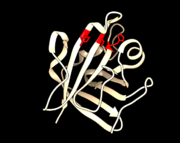Sandbox sortases
From Proteopedia
| Line 18: | Line 18: | ||
'''Class B''' | '''Class B''' | ||
| - | The acquisition of iron plays an important role in the creation of bacterial infections and Class B sortases bind proteins that help sequester iron from the environment. SrtB is a class B sortase found in both ''S. aureus'' and ''Bacillus anthracis''. In both organsims they are associated with binding the protein IsdC to the cell wall which binds to heme and utilize it as a source of iron | + | The acquisition of iron plays an important role in the creation of bacterial infections and Class B sortases bind proteins that help sequester iron from the environment. SrtB is a class B sortase found in both ''S. aureus'' and ''Bacillus anthracis''. In both organsims they are associated with binding the protein IsdC to the cell wall which binds to heme and utilize it as a source of iron <ref>Maresso, Anthony W., Travis J. Chapa, and Olaf Schneewind. ‘Surface Protein IsdC and Sortase B Are Required for Heme-Iron Scavenging of Bacillus Anthracis▿’. 188.23 (29 Sep. 2006): n.pag. 4 Nov. 2015.</ref>. The sequence recognized by class B sortases is NP(Q/K)(T/S)(N/G/S)(D/A) displaying a wider variety of signals. Class B sortases noticeably attaches proteins to different sites in the cell wall than class A sortases. Another difference between SrtA and SrtB is that SrtB and the iron acquiring IsdC are only expressed under iron deficient conditions <ref name= "spirig"/>. |
'''Class C''' | '''Class C''' | ||
| Line 35: | Line 35: | ||
== Industrial and Laboratory Applications == | == Industrial and Laboratory Applications == | ||
| - | Sortases may be very useful in the lab as they can be used to attach a variety of probes to any protein. The probe contains the LPXTG recognisiton sequence for S. aureus SrtA (or LPXTA for Streptococcus pyogenes SrtA) and the target protein acts as the nucleophile in the active site. The reaction can be accomplished in less than three hours | + | Sortases may be very useful in the lab as they can be used to attach a variety of probes to any protein. The probe contains the LPXTG recognisiton sequence for S. aureus SrtA (or LPXTA for Streptococcus pyogenes SrtA) and the target protein acts as the nucleophile in the active site. The reaction can be accomplished in less than three hours <ref>Theile, Christopher S, et al. ‘Site-Specific N-Terminal Labeling of Proteins Using Sortase-Mediated Reactions’. Nature Protocols 8.9 (29 Aug. 2013): 1800–1807.</ref>. Sortases can also be used for in vitro protein ligation. They can ligate a peptide with the correct motif to an aminoglycine peptide. They can also be used to conjugate synthetic branched peptides, (d)-peptides, and aminoglycine-derivatized small molecules to the C terminus of any recombinant protein. The process is touted as “robust, specific, and easy to perform” <ref>Mao, H, et al. ‘Sortase-Mediated Protein Ligation: A New Method for Protein Engineering’. Journal of the American Chemical Society. 9.126 (5 Mar. 2004): n.pag. 4 Nov. 2015. </ref>. |
</StructureSection> | </StructureSection> | ||
Revision as of 18:47, 11 December 2015
This page is setup for Brandon to build his senior project for OU CHEM 4923
Sortase System
| |||||||||||
References
1. McCafferty, Dewey G., and Jeffrey A. Melvin. ‘Sortases’. Handbook of Proteolytic Enzymes. N.p.: Elsevier BV, 2013. 2459–2465. PDF.
2. Spirig, T, EM Weiner, and RT Clubb. ‘Sortase Enzymes in Gram-Positive Bacteria’. Molecular microbiology. 5.82 (27 Oct. 2011): n.pag. 4 Nov. 2015.
3. Maresso, Anthony W., Travis J. Chapa, and Olaf Schneewind. ‘Surface Protein IsdC and Sortase B Are Required for Heme-Iron Scavenging of Bacillus Anthracis▿’. 188.23 (29 Sep. 2006): n.pag. 4 Nov. 2015.
4. Theile, Christopher S, et al. ‘Site-Specific N-Terminal Labeling of Proteins Using Sortase-Mediated Reactions’. Nature Protocols 8.9 (29 Aug. 2013): 1800–1807.
5. Mao, H, et al. ‘Sortase-Mediated Protein Ligation: A New Method for Protein Engineering’. Journal of the American Chemical Society. 9.126 (5 Mar. 2004): n.pag. 4 Nov. 2015.
- ↑ 1.0 1.1 1.2 1.3 1.4 1.5 McCafferty, Dewey G., and Jeffrey A. Melvin. ‘Sortases’. Handbook of Proteolytic Enzymes. N.p.: Elsevier BV, 2013. 2459–2465. PDF.
- ↑ 2.0 2.1 2.2 2.3 2.4 Spirig, T, EM Weiner, and RT Clubb. ‘Sortase Enzymes in Gram-Positive Bacteria’. Molecular microbiology. 5.82 (27 Oct. 2011): n.pag. 4 Nov. 2015.
- ↑ Maresso, Anthony W., Travis J. Chapa, and Olaf Schneewind. ‘Surface Protein IsdC and Sortase B Are Required for Heme-Iron Scavenging of Bacillus Anthracis▿’. 188.23 (29 Sep. 2006): n.pag. 4 Nov. 2015.
- ↑ Theile, Christopher S, et al. ‘Site-Specific N-Terminal Labeling of Proteins Using Sortase-Mediated Reactions’. Nature Protocols 8.9 (29 Aug. 2013): 1800–1807.
- ↑ Mao, H, et al. ‘Sortase-Mediated Protein Ligation: A New Method for Protein Engineering’. Journal of the American Chemical Society. 9.126 (5 Mar. 2004): n.pag. 4 Nov. 2015.

